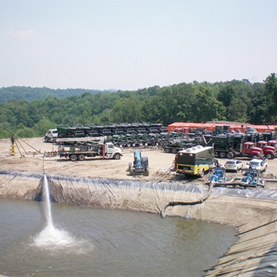RE:RE:RE:RE:RE:RE:RE:RE:BOZ is basically a Poster Child for TSX.vOilman,
We do agree on that, you will not change my mind. How about the Yellowstone River that was "trashed" by 42,000 gal of Canadian Oil? It just seems hypocritical that an OIL MAN comes to this board making a BFD about a very very very minor acid spill (compared to the below) being a big environmental issue and the fact that it might affect salmon fishing and then says that oil and fracking are environmentally friendly yet BOZ is an environental disaster killing salmon and shoulld be shut down.
Since you either do not know or do not tell......Here is just one of 100's of thousands of articles about oil and fracking and the environmental concerns. I own property along the Yellowstone river very near (but just west and upstream) of the oil spill mentioned here. How about my fish or Canada's geese mentioned below? How does BOZ's spill compare to the stuff listed here? Being that you have worked in oil and mining, how would you compare BOZ's environmental issue, assuming the worst media report is correct, to the environmental concerns below?Just wondering your thoughts since you know both oil and mining? Should the regulators seem their full haz mat team to BOZ or would we and the environment be better served by them addressing the below?
I guess it is just a coincidence that we are lucky enough today to have both MINING and OIL MAN here today. And both bad mouthing BOZ. Well, you can probably move on as most of us as there is little left to bash imo.
~
Water Pollution Caused by Fracking~:
Chemical additives are used in the drilling mud, slurries and fluids required for the fracking process. Each well produces millions of gallons of toxic fluidcontaining not only the added chemicals, but other naturally occurring radioactive material, liquid hydrocarbons, brine water and heavy metals. Fissures created by the fracking process can also create underground pathways for gases, chemicals and radioactive material.
The Environmental Protection Agency (EPA) and United States Geological Survey (USGS) have recently confirmed what reside nts of Pavillion, Wyoming had been claiming–that hydrofracking had contaminated their groundwater.
nts of Pavillion, Wyoming had been claiming–that hydrofracking had contaminated their groundwater.
The Environmental Protection Agency (EPA) initially under an emergency administrative order forced three oil production companies operating on the Fort Peck Reservation, to reimburse the city of Poplar, MT for water infrastructure expenditures incurred as a result of drilling contamination. The oil companies appealed the EPA order, but were forced to rectify their violations by a federal judge.
Another scenario for contamination to occur is by faulty design or construction of the cement well casings–something that happened in the BP Gulf blowout disaster. Storage of the waste water is currently under the regulatory jurisdiction of states, many of whom have weak to nonexistent policies protecting the environment.
Soil and Oil Spill Contamination:

Resident Canada geese inhabit impacted portion of Yellowstone River July 9, 2011.![[reuse info]](https://serc.carleton.edu/images/information_16.png)
Provenance: From https://www.flickr.com/photos/usfwsmtnprairie/5921845579
Reuse: https://creativecommons.org/licenses/by/2.0/
According to journalists at Pro Publica, oil companies reported over 1,000 oil spills in North Dakota, 2011, with many more going unreported, state officials admit. The Associated Press also recently reported that the amount of chemically tainted soil from drilling waste increased nearly 5,100 percent over the past decade, to more than 512,000 tons last year. Steve Tillotson, assistant director of the North Dakota Health Department's waste management division, told reporters that trucks are hauling oilfield waste to facilities "24 hours a day, seven days a week."
An ExxonMobil pipeline rupture spilled 42,000 gallons of oil into the Yellowstone River, near Billings, MT. In the aftermath of the spill, ExxonMobil has disclosed that the pipeline has been transporting tar sands oil from Alberta, Canada, which is a low grade, more toxic and corrosive type of oil. Regulators had not been informed that the pipeline was carrying tar sands oil and the disclosure was a result of the spill. Tar sands oil was not in the pipeline at the time of the spill, though regulators are investigating whether or not it played a role in causing the pipeline to corrode